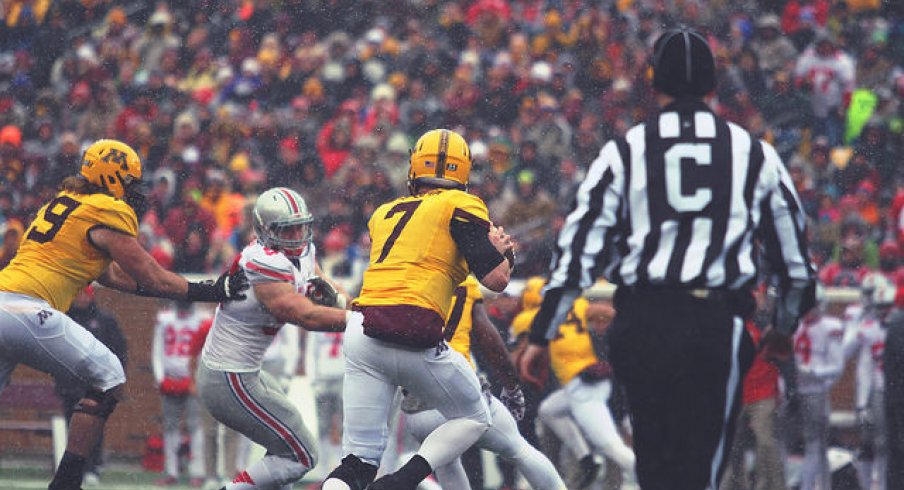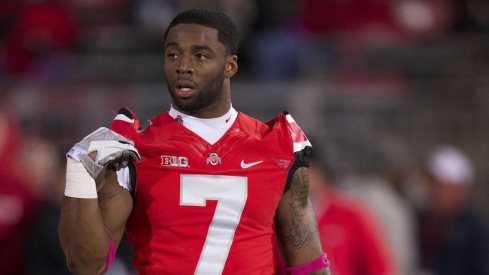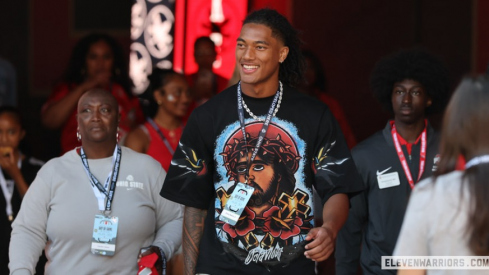After dropping a tough opening-season matchup against No. 2 TCU, Minnesota ripped off three straight wins to enter Big Ten play with a 3-1 record. Now losers of three of their last four games and in the middle of a three-game stretch that will see the 4-4 Gophers play three consecutive games against top-25 teams, the unit desperately needs a win to keep their bowl eligibility hopes alive.
In spite of an inspired performance one week ago in honor of former head coach Jerry Kill, who resigned in the days prior to the game due to health issues, the Gophers ultimately lost to Michigan 29-26 when they failed to punch the ball in from the 18-inch line.
But as the Gophers now face the nation’s second-ranked pass defense in Ohio State, interim head coach Tracy Claeys must remain true to the squad’s offensive identity: a hybrid pro-style/spread offense designed to grind out yards on the ground while scheming open wide receivers and tight ends through play-action.
Even before the loss of star tight end Maxx Williams to the NFL, the Gopher offense has slowly evolved into a unit that runs spread concepts out of smash mouth football formations. Much like Penn State, the Minnesota offensive unit has married traditional pro-style alignments with progressive concepts like the zone blocking scheme (ZBS), Bubble/Now screens, and wide receiver jet motion. The Gophers will huddle and take the snap from under center one play, then move to a no-huddle, check–with-me pace the very next.
They often run their offense out of a variety of pro and spread formations throughout the game, rotating in and out of 11 (one back, one tight end), 12 (one back, two tight ends), and 21 personnel (2 backs, one tight end).



Although the tight end retains an important role in the Minnesota offense, the unit has moved away from a tight end-centric play-action game, relying on skills players at the outside positions to create chunk gains. Sophomore tight end Brandon Lingen currently leads all Minnesota tight ends in pass receptions with 15 on the season at 2.5 per game (good for fourth on the team), compared to leading wide receiver KJ Maye’s 39 receptions (4.9 per game). You will see the tight end targeted this Saturday, often in the red zone, but likely not the volume we have seen in past seasons.
This is a unit that struggles to move the ball with consistency, particularly through the air. The team currently ranks ninth in the Big Ten in total offense (357 yards per game) with a running game that sits at 6th in the Big Ten with 215.5 yard per contest. However, they're 13th in pass offense (141.8 yard per game) as their top three wide receivers have combined for only five touchdowns on the season and average a paltry 51.6 yards-per-game.
Lacking explosive playmakers at the skill positions and suffering from an inconsistent drop-back passing game, the Minnesota offense must manufacture passing yards of their run game. Minnesota’s Big Ten rankings through 10 games clearly illustrate this offensive philosophy: Limit the opponent’s time of possession with the running game and take targeted play action shots when defenses overcommit to the run, a concept known as constraint theory.
(Constraint theory has been discussed in previous Eleven Warrior articles, but the philosophy bears repeating from the always informative Chris Brown).
A well-designed offense revolves around a series of base plays that can be consistently executed (like Ohio State’s tight zone). Over the course of a game, as the offense experiences success running these base plays, defenses will adjust. A constraint play punishes the defense for making that adjustment.
At its core football is a game of numbers. The unit that brings the most numbers to the point of attack will generally win. Ohio State head coach Urban Meyer went so far as to codify this principle in his 2006 Florida Gators playbook.

In order to put together sustained drive and score points, the Gophers' offense MUST punish defenders who overplay their base run game by moving the the ball through the air. How will they do it this Saturday?
The Gophers' bread-and-butter play is inside zone, a close variant of the OSU tight zone concept Eleven Warriors has analyzed previously.


Like Ohio State, the Gopher squad will read off the backside defensive end to eliminate a defender at the point of attack. Below you can see leading rusher Rodney Smith (541 yards) follow the zone running back’s axiom of “speed through the hole, not to the hole” as he lets his blocks develop and makes an authoritative cut in the hole (also known as “pressing the hole”) to hit the second level.

Quarterback Mitch Leidner is a running threat on inside zone as well, as he can pull the ball and bootleg around the pinching defensive end (four rushing touchdown on the year) as he did against Michigan last weekend.

When teams began to overplay Minnesota’s inside zone by aggressively attacking the line of scrimmage with linebackers, offensive coordinator Matt Limegrover has several plays he can dial up to constrain a defense scheming to stop the run. Down by 13 points late in the fourth quarter in an opening-season loss to TCU, the Gophers' offense executed a well-designed play-action concept off inside zone that resulted in a 22-yard touchdown.

The deception starts with the offense’s 11 personnel, a grouping out of which the Gophers' will often run the ball. Running back Rodney Smith takes his normal zone steps through his mesh point with the quarterback, but continues through the line of scrimmage to run a short sit-down route.
Focus on strong side linebacker Ty Summers as Smith approaches the quarterback. Summers bites on the play action, taking two steps towards the line of scrimmage before recovering to start his coverage drop.

Summer’s run steps prove fatal, as he is unable to get enough depth in his drop to reroute the wide receiver running a 'hitch-n-go' route. He is easily beat to the middle of the field for a touchdown, allowing the Gopher's to attempt an onside kick down by a single score.
After Inside Zone, Minnesota's go-to play is Power, an OSU staple since the Jim Tressel days know as Dave. The unit leans heavily on the play in the red zone, running it out of heavy formations, utilizing multiple tight ends and running backs. Former Minnesota Gopher and current Minnesota Viking running back David Cobb gashed the OSU defense in their 2014 meeting to the tune of 145 rushing yards and three touchdowns, with many of his big plays coming of this concept.

Last weekend the Gopher offense took advantage of their play calling tendency to run power in the red zone, pulling the string to run play-action off the concept midway through the first quarter of their 29-26 loss to Michigan. The well-executed play resulted in a first down gain by leading wide receiver KJ Maye to Michigan’s eight yard line.

The most important component of this play action concept is the pulling right guard. Smart teams that run gap-blocking concepts (including Ohio State) will integrate a pulling guard to false key the interior defenders. Pulling a guard in play action is highly effective as linebackers and defensive linemen are usually taught to key the guard-center-guard triangle for run or pass. When front seven defenders see the guard pull, they are conditioned to immediately think “run” and react accordingly. To account for the puller in the protection scheme, the offensive line will protect the quarterback as the routes develop using a form of slide protection.
Re-watch the GIF with a focus on middle linebacker (MIKE) Desmond Morgan (standing on the right hash mark). Notice how the pulling right guard moves Morgan three yards towards the line of scrimmage, creating a clear void by the first down maker for Maye’s route.

Morgan is placed in a no-win situation. If he honors his run/pass key as coached, he must get downhill to his run fit, but this opens up the throwing lane behind him. If he is slow to his run fit, the offense will have the defense outnumbered at the line of scrimmage (remember the numbers game?). A good play-action concept will test the defender’s eye discipline and keys, forcing him to be wrong even if he reacts as he is coached to.
A third staple of the Minnesota rushing attack that provides a variety of constrain options is jet motion. Designed to attack the perimeter, this motion forces defenders to move laterally sideline-to-sideline. With the caveat that the motioned wide receiver must occasionally be handed the ball on the sweep, the concept forces a defense to move one way, before throwing the ball away from their flow.
Down ten points to Nebraska, the Gophers' offense called a jet sweep out of a heavy formation featuring two running backs and two tight ends. The offense disguised the play well, aligning the wide receiver just outside the tackle, instead of the traditional split off the EMLOS (End Man on Line Of Scrimmage). Tight end Nick Hart does an outstanding job leading wide receiver KJ Maye around the corner into the alley for an easy six points.

With the threat of a speedy receiver like Maye taking a jet around the corner for a long gain, defenses must honor the motion or risk giving up the perimeter. When a defense is hit for a long gain by a jet, they tend to over-pursue, creating a lack of defenders away from the motion (back to the math game).
The Gopher offense ran a creative concept off the jet against Kent State, sending Maye in motion before having him pivot and run a swing route to the area cleared by his motion. Focus on the defense’s flow at the snap of the ball:

The entire right side of the Kent State defense reacts aggressively to Maye’s motion, opening up a huge hole for the pivot/swing route. The play works so well that the speedy receiver not only runs into the end zone untouched, but doesn’t see an approaching defender within three yards. The defense buys this beautifully-setup and executed concept hook, line, and sinker.

So, how will the Ohio State defense slow down Minnesota’s run-first passing game? Three factor are critical to stopping any play-action attack:
- Quick, accurate key reads
- Eye discipline
- Film study of opponent tendencies

Interior defenders (the MIKE and WILL) will read the guards while perimeter defenders (SAM and defensive ends) will read the EMLOS (usually a tight end or tackle) for their run/pass key. Interior and perimeter will read using the hi-hat, lo-hat rule (hi-hat generally tips pass blocking while lo-hat generally tips run blocking) and play direction keys (Does the offensive lineman down block? Zone step? Pull?).

Keys hit fast, so defenders must train their eyes to focus on their key without letting the eyes stray to shifts, motion, and other movement designed to test eye discipline.
To determine how well-coached a defensive unit is watch the defenders read their keys. Excellent defenses read and react to run/pass and play direction keys quickly and accurately. Watch the guards and tackles Saturday night. Use the high-hat, lo-hat rule. It happens fast, but with practice you will diagnose run or pass almost as quickly as the players on the field.
The Buckeye defense has been stellar against the pass this season, but the defense will be put to the test by the Gophers' play-action this Saturday. This is a game where the Silver Bullets should challenge themselves to not give up a single long gain through the air. Will the linebackers and defensive backs read their run/pass keys correctly? We'll find out Saturday night.


